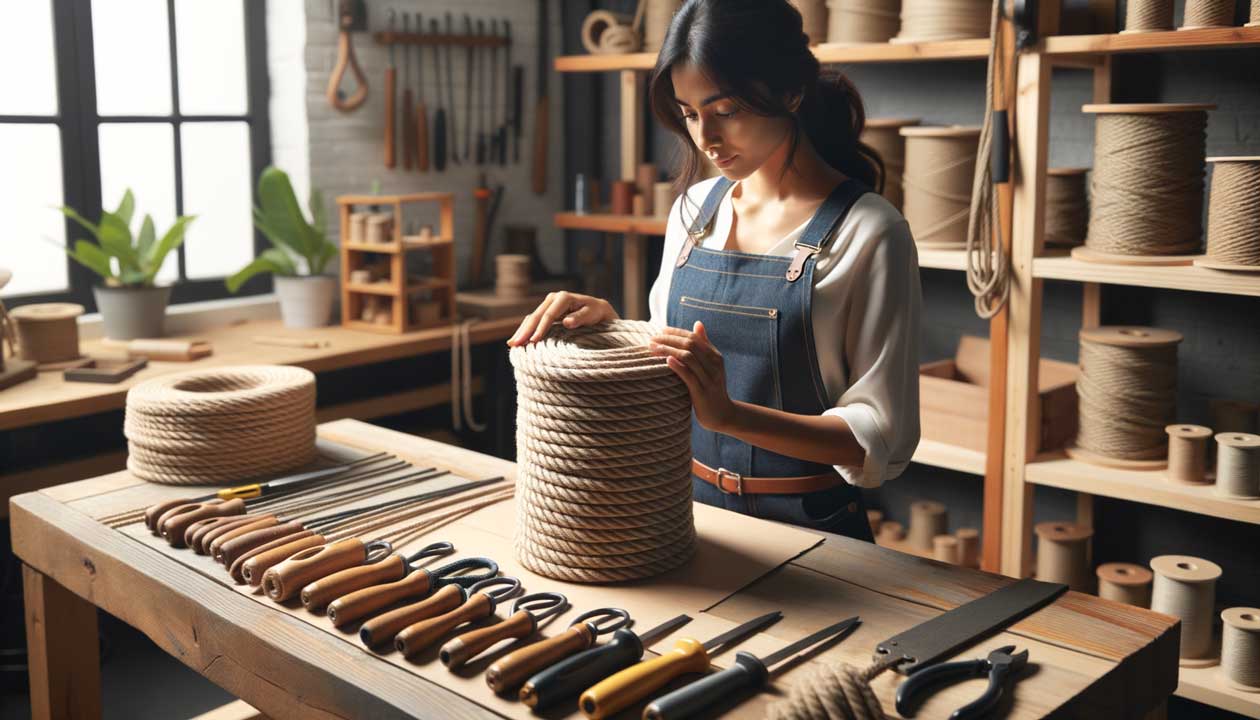Have you ever marvelled at the timeless beauty and unrivalled versatility of Manila rope? This humble yet extraordinary natural fibre, meticulously crafted from the leaves of the abaca plant, has become a trusted companion across countless industries and applications. From the high seas to the backyard, Manila rope has proven itself a true workhorse, blending strength, durability, and resistance to the elements like no other.
As a material steeped in centuries of tradition, 1 Manila rope boasts a rich history and an enduring appeal that captivates both professionals and DIY enthusiasts alike. Its unique properties make it a go-to choice for a wide range of tasks, from rigging sailboats and mooring vessels to creating rustic outdoor décor and supporting climbing plants.
Whether you're a sailor navigating treacherous waters, a farmer bundling crops, or a homeowner seeking to add a touch of natural charm to your living space, understanding the nuances of 3 Manila rope is the key to unlocking its full potential. In this comprehensive guide, we'll delve into the fascinating world of this natural fibre rope, exploring its origins, properties, applications, and the secrets to selecting and maintaining it for optimal performance and longevity.
So, join us on this journey as we unravel the mysteries of Manila rope and discover why this unassuming material has stood the test of time, continually reinventing itself to meet the ever-changing demands of the modern world. Get ready to embrace the beauty, strength, and unparalleled versatility that only Manila rope can offer.
### What is Manila Rope? Exploring the Origins and PropertiesHave you ever wondered about the strong, golden-hued rope that seems to be everywhere, from docks and decks to gardens and crafts? That's Manila rope, a true workhorse in the world of cordage. But what exactly is Manila rope, and what makes it so special?

Manila rope is a natural fiber rope made from the leaves of the abaca plant, a close relative of the banana tree native to the Philippines. Also known as Manila hemp, this wonder fiber has been used for centuries to create ropes prized for their strength, durability, and resistance to the elements.
Discovering the Natural Fibers of Manila Hemp Rope
The journey of Manila rope begins with the abaca plant. Farmers carefully harvest the outer layers of the abaca leaves, revealing the long, cream-colored fibers within. These fibers are then stripped, cleaned, and dried under the sun, transforming them into the raw material for Manila rope production.
The dried abaca fibers are then twisted and spun together to form yarns of varying thicknesses. These yarns are further twisted or braided to create the finished Manila rope, with the number of yarns and the tightness of the twist determining the rope's diameter and strength.
Manila Rope Uses: Versatility in Action
One of the most remarkable aspects of Manila rope is its sheer versatility. From its early days as a go-to choice for marine applications, this natural fiber rope has found its way into countless industries and projects. Let's take a look at some of the most common uses of Manila rope:
- Marine and Fishing: Manila rope's resistance to salt water, UV rays, and abrasion makes it an ideal choice for boat docking lines, fishing nets, and other marine applications.
- Agriculture: Farmers rely on Manila rope for a variety of tasks, such as bundling crops, tying down tarps, and even creating temporary fencing.
- Construction and Landscaping: Manila rope is often used for hauling materials, securing loads, and creating decorative elements in landscaping projects.
- Home and Garden: From outdoor décor to functional applications like hanging plants or creating a rustic handrail, Manila rope adds a touch of natural charm to any space.
As you can see, Manila rope is a true jack-of-all-trades, capable of handling a wide range of tasks with ease. Its unique combination of strength, durability, and aesthetic appeal has made it a favorite among professionals and DIY enthusiasts alike.
So the next time you see a coil of Manila rope, take a moment to appreciate the fascinating story behind this humble yet extraordinary material. From its origins in the lush abaca fields of the Philippines to its countless applications across the globe, Manila rope is a testament to the enduring power and versatility of natural fibers.
Understanding the Properties of Manila Rope
Have you ever wondered what makes Manila rope so special? As we dive deeper into the world of this versatile natural fiber rope, let's take a closer look at its unique properties that have made it a go-to choice for generations.
What is Manila Rope Made of?
Manila rope is crafted from the fibers of the abaca plant, a close relative of the banana tree native to the Philippines. The process of transforming these fibers into rope is a labor of love, involving harvesting, stripping, cleaning, and drying the abaca leaves under the sun.

The resulting Manila hemp fibers are then meticulously twisted and spun together to create yarns of various thicknesses, which are further braided or twisted to form the finished Manila rope. It's a time-honored tradition that has been passed down through generations, resulting in a rope that is both strong and beautiful.
Key Characteristics of Manila Rope
So, what sets Manila rope apart from other types of rope? Let's explore some of its key characteristics:
- Strength: Manila rope boasts an impressive strength-to-weight ratio, making it capable of handling heavy loads without adding excessive weight.
- Flexibility: Despite its strength, Manila rope remains flexible and easy to handle, allowing it to conform to various shapes and applications.
- Durability: The natural fibers of Manila rope are resistant to abrasion, wear, and tear, ensuring that it can withstand the test of time and tough conditions.
- Saltwater Resistance: One of the most remarkable properties of Manila rope is its ability to resist damage from saltwater, making it an ideal choice for marine applications.
These characteristics combine to create a rope that is not only functional but also versatile, making it suitable for a wide range of applications, from marine and agriculture to construction and home décor.
Advantages and Disadvantages of Manila Rope
While Manila rope has many advantages, it's essential to understand its limitations as well. Let's take a look at some of the pros and cons of using this natural fiber rope:
Advantages:
- Affordable compared to other natural rope options
- Versatile and suitable for various applications
- Biodegradable and eco-friendly
Disadvantages:
- Prone to water absorption and shrinkage when wet
- Susceptible to UV damage and rotting if exposed to sunlight for extended periods
- Limited stretch and shock absorption compared to synthetic ropes
To mitigate these disadvantages, it's crucial to properly care for and maintain your Manila rope. Treat it with mineral oil to prevent brittleness and fraying, and store it in a cool, dry place away from direct sunlight when not in use. With proper care, your Manila rope can provide years of reliable service.
As you can see, understanding the properties of Manila rope is essential for selecting the right rope for your specific needs. Whether you're a sailor, farmer, craftsman, or DIY enthusiast, knowing the strengths and limitations of this natural fiber rope will help you make informed decisions and get the most out of your Manila rope projects. For additional tips on customizing rope for specific needs, consider exploring our custom rope solutions.
Popular Applications of Manila Rope
Have you ever marveled at the natural beauty and functionality of Manila rope? This durable, all-purpose rope, crafted from the fibers of the abaca plant, has been a trusted companion for centuries in a wide range of outdoor applications. From the seas to the backyard, Manila rope's versatility knows no bounds.
As someone who has spent countless hours working with various types of rope, I can confidently say that Manila rope stands out for its unique combination of strength, durability, and resistance to the elements. Its natural fibers, meticulously processed and spun into a robust cordage, make it an ideal choice for tackling demanding tasks in challenging environments.
Marine and Sailing Uses
One of the most prominent applications of Manila rope is in the marine and sailing industry. Its exceptional resistance to salt water and UV rays makes it a go-to choice for a variety of onboard tasks. Whether you're rigging a sailboat, mooring a vessel, or securing anchor lines, Manila rope provides the reliable performance and longevity needed to withstand the harsh conditions at sea.
In my own sailing experiences, I've witnessed firsthand the critical role Manila rope plays in ensuring the safety and functionality of a vessel. From the satisfying texture of a well-worn docking line to the reassuring strength of a properly tied knot, Manila rope has been a constant companion on my nautical adventures.

Landscaping and Outdoor Activities
Beyond the high seas, Manila rope has found its way into a multitude of landscaping and outdoor applications. Its natural aesthetic and durability make it a popular choice for creating functional and visually appealing outdoor spaces. From lining garden beds and supporting climbing plants to crafting rustic handrails and fences, Manila rope adds a touch of organic charm to any landscape design.
For outdoor enthusiasts, Manila rope is a trusted companion in various activities. Its strength and flexibility make it suitable for climbing and rappelling, while its resistance to weathering ensures long-lasting performance in camping and hiking gear. In my own backyard, I've used Manila rope to create a charming rope swing for my children, providing hours of entertainment and memories that will last a lifetime.
- Playground equipment: Manila rope is a popular choice for creating safe and durable playground structures, such as rope bridges, cargo nets, and climbing frames.
- Agricultural applications: Farmers and ranchers rely on Manila rope for tasks like bundling hay, securing livestock enclosures, and suspending harvested crops for drying. If you're interested in other agricultural fibers, our String Twine and Nylon Twine String might be worth exploring.
- Decorative purposes: The natural beauty of Manila rope lends itself well to decorative applications, such as creating nautical-themed décor, rustic wedding centerpieces, and unique handicrafts.
The versatility of Manila rope is truly astounding. Its strength, durability, and natural charm make it an indispensable tool in a wide range of outdoor applications. Whether you're a sailor navigating the open seas, a landscaper crafting a beautiful outdoor oasis, or an adventurer exploring the great outdoors, Manila rope is a reliable companion that will stand the test of time.
For those involved in marine applications, be sure to check out our Ultimate Guide to Custom Marine Rope.
So the next time you find yourself in need of a dependable and versatile rope, look no further than Manila rope. Its rich history, exceptional properties, and endless possibilities make it a true gem in the world of cordage. Embrace the natural wonder of Manila rope and discover for yourself the countless ways it can enhance your outdoor experiences and projects.
Selecting and Maintaining Manila Rope
When it comes to choosing the right Manila rope for your project, there are several key factors to consider. As a versatile and durable natural fiber rope, Manila rope is an excellent choice for a wide range of applications, from construction and landscaping to outdoor activities and more. However, to ensure that you get the most out of your Manila rope, it's essential to select the right type and take proper care of it.
How to Select the Right Manila Rope
One of the first things to consider when selecting Manila rope is the grade. Manila rope is typically available in three grades: Class 1, Class 2, and Class 3. Class 1 Manila rope is the highest quality and most durable, making it ideal for heavy-duty applications and load-bearing tasks. Class 2 and Class 3 ropes are suitable for lighter-duty applications and decorative purposes.
When choosing the right Manila rope for your needs, consider the following factors:
- Intended use: Determine the primary purpose of the rope and select a grade that matches the required strength and durability.
- Load requirements: Consider the weight and stress the rope will be subjected to, and choose a diameter and grade that can safely handle the load. For other heavy-duty applications, explore our Heavy-Duty Winch Rope.
- Environmental conditions: Take into account the environment in which the rope will be used, such as exposure to water, UV rays, or abrasive surfaces.

Before making a purchase, it's also essential to inspect the rope for quality. Look for a rope that is free from defects, such as frayed or broken fibers, discoloration, or inconsistent thickness. A high-quality Manila rope should have a smooth, uniform appearance and feel sturdy to the touch.
Proper Care and Maintenance for Manila Rope
To ensure that your Manila rope lasts as long as possible, it's crucial to provide proper care and maintenance. One of the most important aspects of caring for Manila rope is storage. Always store your rope in a cool, dry place away from direct sunlight, as exposure to moisture and UV rays can lead to mildew, rot, and deterioration.
Another way to extend the lifespan of your Manila rope is by treating it with a rope oil or preservative. These products help protect the fibers from UV damage, prevent fraying, and maintain the rope's flexibility. Apply the oil or preservative according to the manufacturer's instructions, ensuring that the rope is clean and dry before application.
- Regular inspection: Periodically examine your Manila rope for signs of wear, such as fraying, discoloration, or loss of flexibility. Address any issues promptly to prevent further damage.
- Cleaning: If your rope becomes dirty, clean it with a mild detergent and warm water. Rinse thoroughly and allow the rope to air dry completely before storing or using it again.
- Proper coiling: When not in use, coil your Manila rope loosely to avoid kinks and tangles. Start by creating a small loop at one end and wrapping the rope around itself, maintaining a consistent tension throughout.
By following these selection and maintenance tips, you can ensure that your Manila rope remains strong, reliable, and ready to tackle any task you have in mind. Whether you're a professional tradesman or a DIY enthusiast, investing in high-quality Manila rope and providing proper care will help you get the most out of this versatile and eco-friendly material.
So, the next time you embark on a project that requires a dependable and sturdy rope, reach for Manila rope with confidence. With its rich history, outstanding properties, and endless applications, Manila rope is truly a timeless choice that will serve you well for years to come.
Manila rope, renowned for its strength and golden hue, is crafted from the abaca plant's fibers, making it a versatile and durable choice for many applications. Whether you need 1 manila rope for heavy-duty marine use or 3 manila rope for decorative projects, it excels in both strength and flexibility. Its natural resistance to saltwater, UV, and abrasion ensures longevity. Ideal for marine, agricultural, and home uses, this eco-friendly rope is both functional and aesthetically charming. Proper selection and maintenance can significantly extend its lifespan, proving that Manila rope remains a timeless material for diverse needs.
Unlock the Potential of Manila Rope
Fill in the inquiry form above to learn how our Manila rope can enhance your projects. Discover its exceptional properties and explore bespoke solutions tailored to your needs.